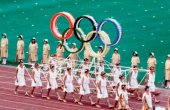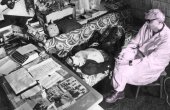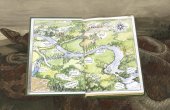Subterranean Paris: Félix Nadar’s Descent Into the Parisian Underground
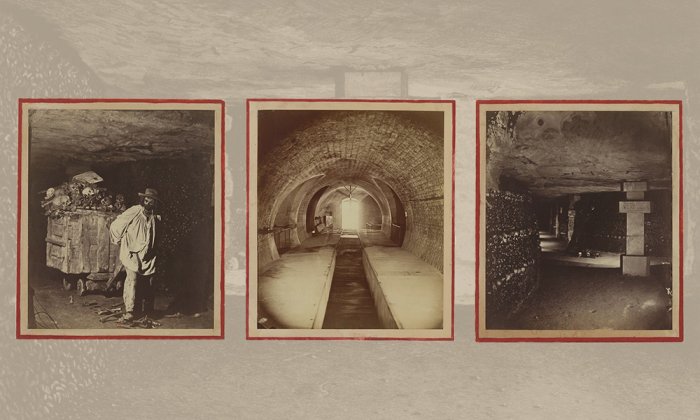
In 1900, at the age of 80, the pioneering photographer Félix Nadar published his memoir Quand j’étais photographe (“When I Was a Photographer”). It was finally translated into English in 2015. Composed as a series of 14 vignettes, “When I Was a Photographer” is one of the most wonderful accounts we have not only of Nadar’s richly intense and compelling life but also of the early decades of photography. Charming, often humorous, and imbued with the author’s rogue personality, each vignette functions as an opening onto the reading labyrinth that is at once Nadar’s life and text. In the excerpt from the book that follows — two isolated passages from an entry titled “Subterranean Paris,” accompanied by a handful of photographs — Nadar chronicles his descent into the sewers and catacombs of Paris, where he experimented with the use of artificial lighting, producing the first images of their kind.
The postern is opened. Each person goes slowly down the narrow staircase with its sharp turn. Would it please you to find out that this entrance, the most frequented, is counted as one of the 60 leading into the Parisian Catacombs, and also that its staircase has 90 steps? I would like to believe that these statistics do not interest you any more than they interest me.
Besides, to begin with, I do not know who could assume the responsibility of enumerating exactly the six or seven millions of skeletons that for more than 10 centuries have been bequeathed to us here, an unexploited mine of calcium phosphate and potassium nitrate.
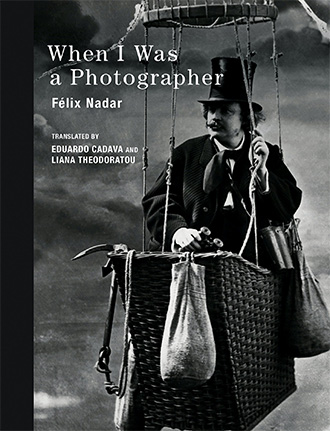
Finally here we are at the bottom of the interminable and slippery staircase. Following the first ones in our single file, and followed by others, we walk through a narrow gallery with damp walls whose crushed vault makes the tallest people bend over. The monotonous procession extends and, in order to make it even more unpleasant in this viscous atmosphere, the smoky smell of this succession of candles — and, in any case, isn’t there some candlestick lagging behind? — is condensed and congealed in this long airless corridor.
But space becomes wider around us. A door appears to us: on it the inscription:
MEMORIAE MAJORUM
and on both sides: HAS ULTRA METAS REQUIESCUNT,
BEATEM SPEM EXPECTANTES1
It’s here. We are entering the ossuary.
Between the huge, roughly squared pillars of stone, built in order to preserve this southern part of Paris from the frequent landslides (one could liken them to the immense site of a meticulous timber merchant), all the bones collected, mostly since 1785, from abandoned cemeteries, ancient churches, and the excavations which, under the Second Empire, have turned a large part of the Parisian soil upside down, are arranged in perfect order. From the time of the Caesars and the Norman invasions until the last bourgeois and peasants were extracted from Vaugirard cemetery in 1861, all those who lived and died in Paris sleep here, lowly multitudes and acclaimed great men, canonized saints and criminals executed in Place de Grève. In the egalitarian confusion of death, a Merovingian king remains in eternal silence next to those massacred in September 92. The Valois, Bourbons, Orléans, Stuarts, end up rotting indiscriminately, lost between the wretched of the Court of Miracles and the 2,000 “of the religion” that were killed on the night of St. Bartholomew.
In the egalitarian confusion of death, a Merovingian king remains in eternal silence next to those massacred in September 92.
But the nothingness of the human condition has no limits and the standards of eternity demand even more: These skeletons, all pell-mell, are themselves disaggregated, scattered in such a way as never to be able to be found in order to be reunited on Judgment Day. By the hand of special workers, employed annually for this service, the ribs, vertebrae, sternums, carpi, tarsi, metacarpi, and metatarsi, phalanges, etc., the whole menu of the bones, are pushed back, compacted into more or less cubic masses under the crypts — in jams, as they say here —, and held in front by heads chosen from the best-preserved of them: what we call the façades. The art of the excavation workers combines these strings of skulls with femurs arranged in a cross in certain symmetrical and varied arrangements, and our funerary decorators devote themselves to them — “in order to make the view interesting, almost pleasant,” says the good Dulaure, evidently seduced, but a statement which Mr. Paul Fassy, in his very interesting work on the Catacombs, has some reason to treat as “partial.”2
Thus, the skulls that compose this “façade” in front of which we pass come from the rue de la Ville-Levesque, where some of those executed in 1793 were thrown together. Among them, undoubtedly, is Philippe Égalité, Duke of Orléans. Which one? …
And this little verse from the first chapter of St. Luke, fatal like a sentence, is it pure chance that chose it to be engraved here? DEPOSUIT POTENTES DE SEDE ET EXALTAVIT HUMILES.3
It is established that they are all there in their mixed up fragments: St. Geneviève and Mirabeau, Marat with Nicolas Flamel “and his wife,” St. Vincent de Paul and Cardinal Dubois, Marguerite de Bourgogne with the provost Marcel, Perrault, the architect storyteller, Marshal d’Ancre, Voiture, Cassini, Benserade, St. Médéric, Gaultier-Garguille, Malherbe, Gassendi, Philippe de Champaigne, Lulli, Rabelais, Commines, etc., Frédégonde perhaps lies intermixed with Miss de la Vallière and Miss de Scudéry by the shambles of Turlupin between Pichegru and Father Santeuil.
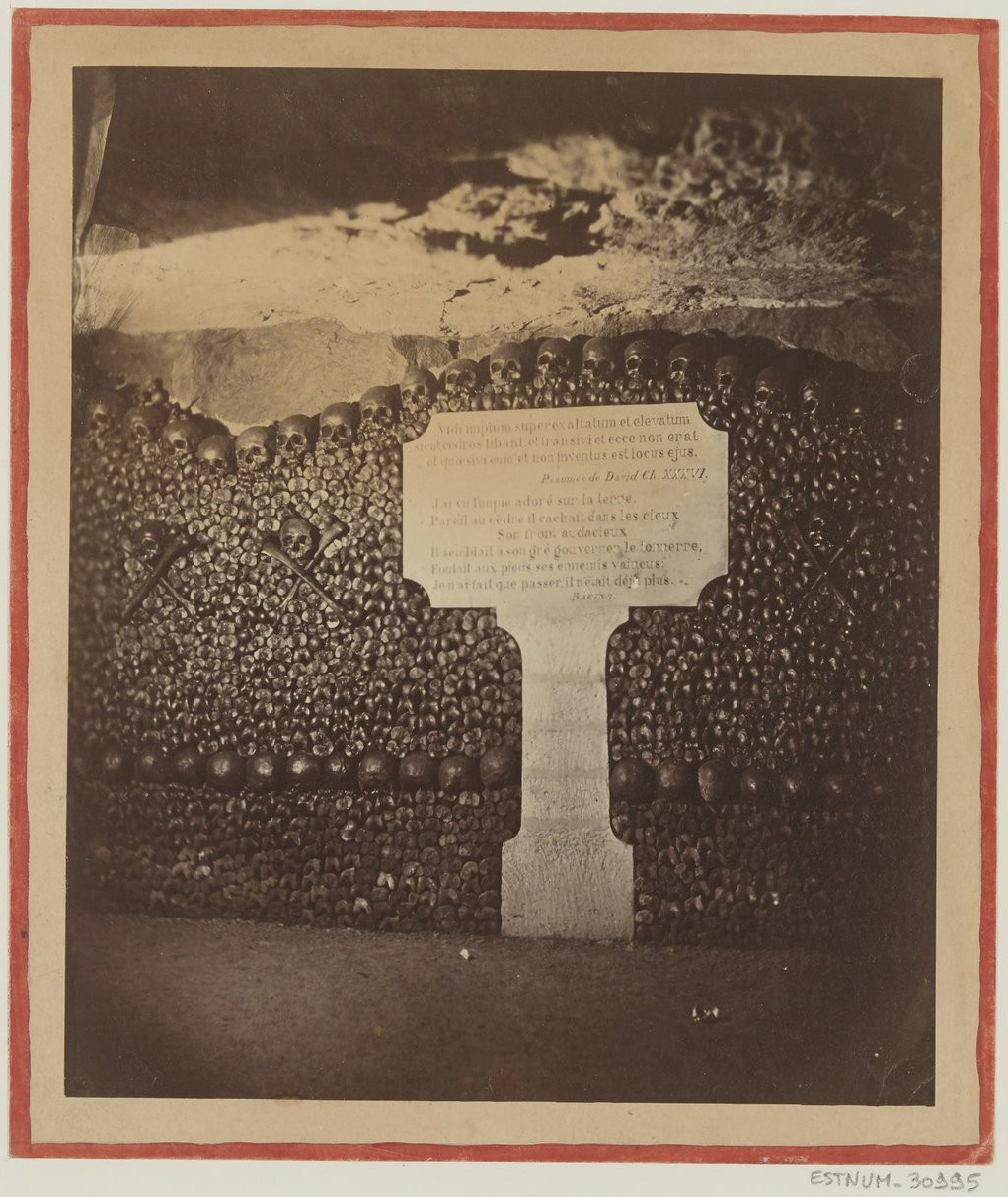
This is the parade of the great names of France as well as of the small ones. There is not even one of our old families that does not have someone to claim there, Condés and Contis, Soyecourt and Vendôme, La Rochefoucauld, Créqui, Rohan, Montmorency, Villars, Blacas, Brancas, Noailles, Du Lau, La Trémoille, Nicolai, Luxembourg, Molé, etc., lifeless here and there, every trace implacably lost in the uncountable clutter of the most humble, the anonymous, the Durands, Legrand, Petit, Lemaître, Berger, Lenoir or Leblanc.
This fragment that your foot just bumped into, this debris without a name, is perhaps one of your grandfathers, a grandmother perhaps, Madam. And this one has loved, this one has been loved …
What human vanity, what pride could stand before this final, inevitable promiscuity of our ashes, when, only yesterday, the jaw of a Cardinal Richelieu circulated among the antique stores followed on the track by reporters — when, as with papers in hand, one of the most serious, erudite scholars affirmed to me, the expiatory Chapel, this venerated place of pilgrimage for the last faithful ones, would not contain a vestige of the relics of Louis XVI, but precisely the detested bones of a Robespierre? What nobility, what titles, what cartularies, what seals? Search it, your glorious register, in these heaps and heaps without end, poor fool!
It was decided, especially in recent years, to distinguish the bones of diverse origins. Lapidary inscriptions indicate that this cluster comes from Picpus, another from the convent of the Cordeliers or from the Market of the Innocents. These inscriptions alternate with Latin verses from the Bible and with French fragments, the majority of which are annoyingly unearthed from a tenacious selection of our minor poets, Lemierre, Ducis, the already named Delille, and other Campistrions.
I imagine that, in this almost perpetual darkness, these fish are in the process of becoming blind, like the atrophied vision of species found in underground lakes and cave-dwelling insects.
A small stream of water, clear and always at the same level in its stone basin, serves as an asylum to five or six small fish imported by the fancy whim of a site worker, who presents them to us with a certain pride. I imagine that, in this almost perpetual darkness, these fish are in the process of becoming blind, like the atrophied vision of species found in underground lakes and cave-dwelling insects. Above the source: SICUT UNDA DIES NOSTRI FLUXERUNT.4
This is certainly one of those deep thoughts to which neither Bourdaloue nor even Mr. Prudhomme could find the means to say no.5
Further on, but outside the ossuary, is a very large and deep well, into which we were irresistibly tempted to descend. But be careful: The water is so clear that one can perceive it only when one touches it and I warn you that the footbath is freezing: I have personal experience.
On the side, two examples of architectural sculpture, carved in tuff:
QUARTIER DE CAZERNE (sic)
PORT SAINT-PHILIPPE 1777,
say the artist’s inscriptions. These works of patience, which in no way bear comparison with the colonnade of the Louvre, are owed to the leisure of an old soldier named Décure who had apparently chosen to retire there, and who, according to the local tradition, perished there under a landslide, victim of his own imprudence.
Here, too, in order not to forget anything, a heavy table similarly carved in solid stone, on which, according to the same tradition, Charles X had a quick meal.
The legends on gravestones testify that the victims of the
BATTLE AT THE CHÁTEAU DES THUILERIES (sic)
ON THE 10TH OF AUGUST 1792
were reunited in this other place, and then here those of the
BATTLES OF THE PLACE DE GRÈVE, OF THE HÔTEL
DE VILLE, OF THE HÔTEL DE BRIENNE, AND OF
THE RUE MESLAY, ON THE 28TH AND 29TH
OF AUGUST 1788
and there those of the
BATTLE AT THE RÉVEILLON FACTORY,
ON THE 28TH OF AUGUST 1789.
This other inscription is even more striking in its lapidary succinctness:
D. M.
II and III
September
MDCCXCII
A gravestone, the only one that we found here gathered among so many thousands of others of greater interest, still stands to teach us in prose and in verse that it covered the body of Françoise Gellain, wife of Legros, who assisted in the escape of Latude.
Here is the sarcophagus called TOMBEAU DE GILBERT, from which Gilbert is missing. But he cannot be far away.
And the provisional altar where at least once a year, I suppose, a regulatory Mass must be said for so many dead, Catholics, Huguenots, Jews or even Mohammedans, always in wait for the special chapel which the here present pamphleteering Timon de Cormenin, once deadly to the profiteers of the old civil list, never ceased to demand. Here the path is blocked. This enormous pile of bones, a landslide whose summit pierces the vault, comes from the well of the rue de la Tombe-Issoire (or just simply Tombissoire?). In this well, all the human remains unearthed in the eliminated cemeteries and in the debris excavated for the creation of new roads, since death itself cannot safeguard us against expropriation, are unloaded little by little.6 The workers of the ossuary heap them up in each of these two dump carts which, once full, they push in front of them toward the still empty arches which wait for their “filling.”
Next to the pile, a small bier, entirely new. A map recently nailed, written by hand, tells us that the remains that it contains have been designated and reserved to be buried elsewhere. The decomposition in the tomb has not left much to keep, since it is really a child’s coffin. But what! among so many beings, once so dear, only one evoked! Is our family piety extinguished, too, then? And before the conclusive and universal abandonment, wasn’t there a way for the officials of this necropolis, where everything vanishes, even the remembrance of the fathers in the memory of the sons, to replace one of the distiches of their Chênedollés of choice by the piercing cry that escapes like a sob from the psalmist’s bosom:7
Oh, you who were my friends, have pity on me!
And yet more bones and inscriptions, always sorted out from the repertoire of academic minores and minimi … Haven’t you had enough, Madam? The picturesque is quickly exhausted here, the points of view are not varied, and even if we always spun ourselves around we would not see anything different. This mysterious word — catacombs — by itself excites a curiosity that, going back a long way, has taken its time to develop. Not everyone has the leisure, the opportunity, or the thought to descend here — and there were sufficient reasons to come. But you have already discovered, like me, that a few steps in these subterranean passages are enough to satisfy your curiosity. It is one of those places that everyone wants to see and no one wants to see again.
Let us then climb this staircase which appears to our impatience even more interminable than the descent — and here is the sweet air of the outside, here is the light, the sun, life, which chase away from us, like a bad dream — even worse, a boring dream — the memory of a funereal excursion.
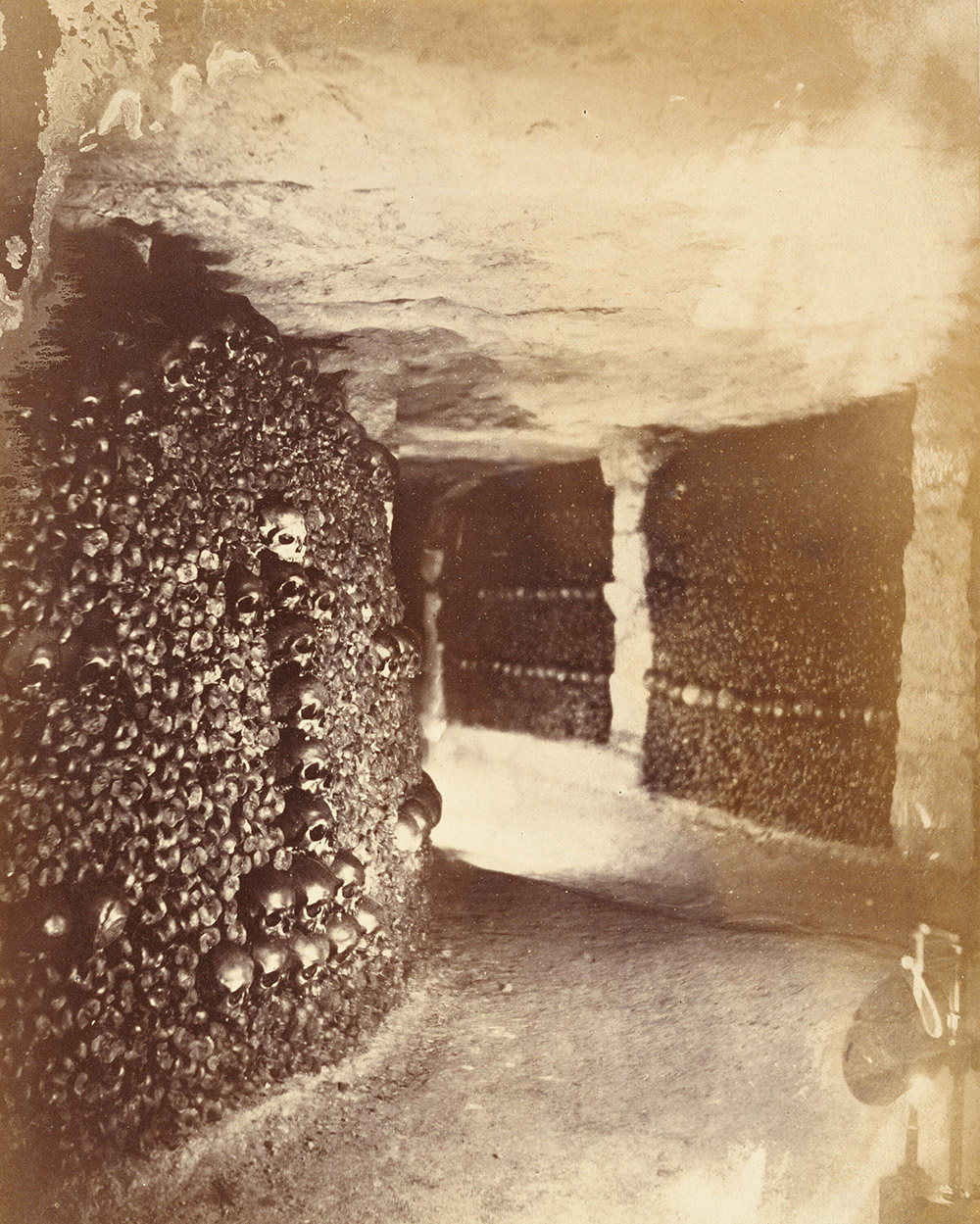
We now go back down to work.
We will ask our lens to do without daylight in order to “render” to us what “it sees” with us: We will attempt the first underground experiment of photography with artificial light, which has already successfully replaced sunlight in our portrait studio.
But, in this place, this requires some explanation.
Most of these operations that we commonly perform today with perfect ease seemed, before the first attempt, an impossibility, even an affront to common sense.
As in my attempt at aerostatic photography, so loudly opposed and denied by the experts, I encountered more than one naysayer when I set out to compensate for the deficiencies of daylight with artificial illumination, which would seem necessary, after all, in the majority of cases where sunlight is lacking or insufficient. Having conceived the idea, I began the preparations. At first, electricity was used for prolonged operations and magnesium in specific conditions. But at that time (1858) electricity was still quite a long way from the practical applications toward which it would soon stride with gigantic steps. We did not have the precious portable accumulators, or the intermediary generators of Gaulard,8 or all the other equipment we have now, and we were forced to accept all the cumbersome inconveniences of the Bunsen battery. We had no choice.
Most of these operations that we commonly perform today with perfect ease seemed, before the first attempt, an impossibility, even an affront to common sense.
I therefore had an experienced electrician install, on a solid part of my terrace on the boulevard des Capucines, 50 medium elements that, as I had hoped, turned out to be sufficient in providing me with the required light. I pass over the embarrassment and difficulties of installation and handling, all venial compared to the obstacles that I was to encounter later — when I took them outside.
My first application rightly belonged to the portrait before I launched myself into expeditions taken outside.
I naturally began the experience in anima vili, on myself and on the personnel of my laboratory. As mediocre and even detestable as these first negatives were, the news of the attempt had spread in our photographic microcosm, in which everyone kept an eye on his neighbor, and I was soon invited to give a talk for the Circle and journal la Presse scientifique, which at that time had its headquarters at rue Richelieu, next to the fountain of Pradier — the pleasant but incoherent sculptor of whom Préault said: “he leaves every morning for Athens and he returns every evening to Place Bréda.”9
Having immediately transported all my bulky equipment to rue Richelieu, I obtained various negatives — among others, the group of the President and his two assessors at their office —, negatives whose positives I made right away with my electric light source.
These first negatives came out coarse, with clashing effects, the blacks opaque, cut without details in every face. The pupils either extinguished by excessive luminosity or brutally sticking out, like two nails.
In order to perfect them, we needed a second source of softened light, penetrating the shaded parts. I tried bursts of magnesium; but we did not yet have the so propitious lamps invented later, and the use of magnesium, let alone of smoke, presented a number of problems.
I tried to attenuate my light by placing frosted glass between the lens and the model, which did not help me much; then, more practically, I arranged reflectors on white twill, and finally a double set of large mirrors reflecting intermittently the luminous light source of the shaded parts. I thus managed to restore my exposure time to my daily average; finally I was able to obtain negatives with equal speed and of totally equivalent value to that of the negatives executed daily in my studio.
I would not pause over these experiments and over the gradual progress of research indicated by the most elementary practical sense if we had not seen, some years ago, two photographers, one of whom is well known, dispute excessively in court the priority of processes applied and divulged many years before they took up arms.
The presence, at dusk, of that then little-used light would stop the crowd on the boulevard and, drawn like moths to light, many curious people, friendly or indifferent, could not resist climbing the stairs to find out what was happening there.
These visitors of all classes, some of whom were known or even famous, were well received, gratuitously providing us with a stock of models, all disposed to the new experience.
It is in this way that in these evenings I photographed, among others, Niépce de Saint-Victor, G. de La Landelle, Gustave Doré, Albéric Second, Henri Delaage, Branicki, the financiers É. Pereire, Mirès, Halphen, etc., and finally my neighbor and friend from across the street, Professor Trousseau.
The possibility of photography in artificial light was therefore from then on secured; it was now only a matter of proceeding to the desired application.
The subterranean world was opening up an infinite field of operations no less interesting than the telluric surface. We were going to penetrate, to reveal the mysteries of the deepest, the most secret caverns.
But without going immediately so far, and in order to begin at the beginning, a first task would present itself under our very feet: The catacombs of Paris, without bearing the solemn lessons of the Roman catacombs in their memories, have their secrets to tell us, and, above all, we have to acknowledge the admirable human work accomplished in the network of our Parisian sewers.
Based on the trial and error of our first experiments in the studio, a practitioner quickly could have foreseen the difficulties awaiting us in localities entirely unready to receive us.
The first of our impediments was the cumbersome baggage of our batteries, successively distributed on one or two carriages. All combinations tested, exhausted, finally ended up failing, confronted with the narrowness of some of these underground paths, strangled in certain places like molehills …
We were forced to leave this part of our equipment outside, on the public road, from where it could communicate with us through one of the small municipal craters, the catacomb pits or manholes. We would roll it from one of these holes to the other as we proceeded in our underground operations.
The supervision of an attentive staff did not always manage to protect the equipment sufficiently against the curiosity, the indiscretion, of the gathering passersby. The crowd is everywhere inopportune, obtrusive, and if Parisian idle curiosity did not steal its reputation, it is not because it is more childish there than everywhere else (we have encountered at least equal stupidity in all the cities and towns of all countries without exception), it is because Paris offers a denser public.
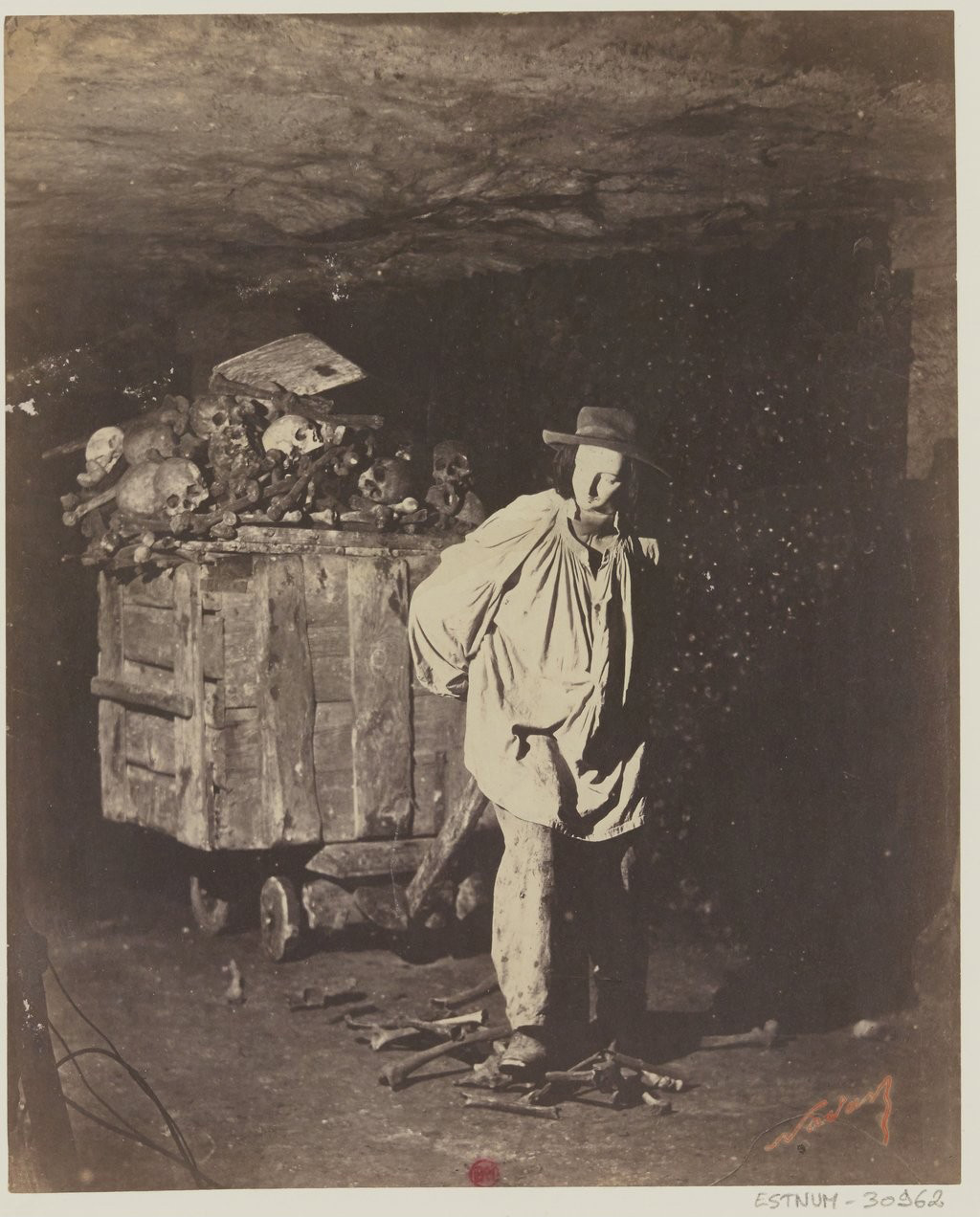
The remoteness of the home generator did not facilitate our operations. At every moment we were up against the slowness of the arrangements or modifications, against the forced intervals of the practical work, or against some unforeseeable incident. A number of times, from our burrows where time was already too long — “we grow old here!,” an aide would say —, we hastily had to send a messenger through makeshift roads in order to get information about some sudden stop which was forcing us to painfully restart an operation, an already difficult operation, exactly at the moment in which it was coming to an end.
At certain points, the distance from the mouths of communication imposed on us an exaggerated development of secondary conductors, and, not to mention all the other inconveniences or difficulties, we needed at every move to test our exposure times empirically; now, some of these plates were found to require up to 18 minutes. Remember that we were still using collodion emulsion, which is slower than Lumière plates.
I had judged it advisable to animate some of these scenes by the use of a human figure, less in order to render them picturesque than in order to give a sense of scale, a precaution too often neglected by explorers in this medium, sometimes with disconcerting consequences. For these 18 minutes of exposure, I found it difficult to obtain absolute, inorganic immobility from a human being. I tried to get around this difficulty by means of mannequins, which I dressed in worker’s overalls and arranged on the stage with as little awkwardness as possible; this detail did not complicate our tasks.
But I couldn’t say how many times our work was interrupted, stopped, for one reason or another. Sometimes the weakened acids were not sufficiently replenished and we had to stand at attention during these unpleasant delays, suspending all operations. Twice I had to change the operator whom we had contracted to supply our light. Should we still talk about our disappointment, our anger, when, after many efforts to overcome a difficult problem, at a moment in which, having taken all precautions and eliminated or circumvented all obstacles, our decisive operation was nearing its end — suddenly, in the last seconds of the exposure, a cloud rising from the canal came to veil our photograph — and how many imprecations, then, against the beautiful woman or the good man above us, who, without suspecting that we were there, chose that exact moment to replenish the water in their bathtub!
This nasty work, through sewers or catacombs, lasted no fewer than three consecutive months. I would not wish these three months of holiday on my worst enemy, if I had one.
We have to take into account that this nasty work, through sewers or catacombs, lasted no fewer than three consecutive months. I would not wish these three months of holiday on my worst enemy, if I had one. I had given much more than I could give and I had reached the limit of my patience. I stopped — with regret, however, since the work, as I had envisaged it, was not yet entirely completed. But, somewhat nervously, I was recalled to the studio by necessities that, after such a long absence, were even more urgent. In short, I brought back a hundred negatives, most of them very good, some truly so perfect that they seemed to have been achieved sub Jove, sub sole.10 In any case, they cost me a lot, but I did not regret anything.
I hastened to offer the first hundred proofs to the collections of the Ville de Paris through the hands of the eminent engineer of our underground constructions, Mr. Belgrand: our work testified to his glory. A few months later, he did me the honor of requesting a second collection with which I had again the pleasure of paying him homage.
Félix Nadar (1820–1910) is one of the greatest figures in the history of photography. This article is excerpted from his memoir “When I Was a Photographer,” originally published in 1900 and translated into English in 2015.
- The Latin phrases here translate as “In memory of the ancestors” and “Beyond these borders, they rest in the expectation of the hoped-for happiness,” respectively.
- Nadar refers here to Jacques-Antoine Dulaure (1755–1835), French archaeologist and historian who wrote extensively on the history of Paris, France, and the French Revolution. The most important of his works is his ten-volume Histoire physique, civile et morale de Paris depuis 1821 jusqu’à nos jours (1825); and to Paul Fassy (1833– ?), who published his Les Catacombes: étude historique in 1861.
- Luke 1:52: “He hath put down the mighty from their seats, and he hath raised the lowly ones.”
- “Our days passed like water.”
- Louis Bourdaloue (1632–1704), French Jesuit and court preacher. Well-trained in rhetoric, philosophy, and moral theology, he was known as the “king of preachers and the preacher of kings”; Joseph Prudhomme was a character created by Nadar’s friend, the lithographer, caricaturist, actor, and writer Henri Monnier (1799–1877). Prudhomme was the personification of the 19th-century Parisian bourgeoisie who, in turn, was modeled in part on Monnier himself. Prudhomme was adopted by Honoré Daumier, who included him in more than 60 caricatures.
- Although the church opposed the public display of “sacred” human bones, public demand moved the French government to open the Catacombs to the general public in 1867. 1867 was of course also the year of the Universal Exhibition, in which several archaeological displays presented skeletal remains.
- Charles-Julien Lioult de Chênedollé (1769–1833), French poet who published his Le genie de l’homme in 1807 and his Études poétiques in 1820. He was particularly interested in the relations between man, nature, society, and the world of astronomy.
- Lucien Gaulard (1850–1888), inventor of instruments for the transmission of alternating current electricity. Best known for his development of a power transformer.
- Jean-Jacques Pradier (1792–1852), Swiss-born French sculptor who worked in the neoclassical style and contributed to the Fontaine Molière in Paris. He was friends with several writers, including Victor Hugo, Théophile Gautier, and Gustave Flaubert; Antoine-Augustin Préault (1809–1879), French Romantic sculptor who first exhibited at the Paris Salon in 1833 and whose most famous surviving work is his 1876 relief sculpture of Ophelia, now in the Musée d’Orsay
- “Under Jupiter, under the sun”; that is: in the open air, under the sun
